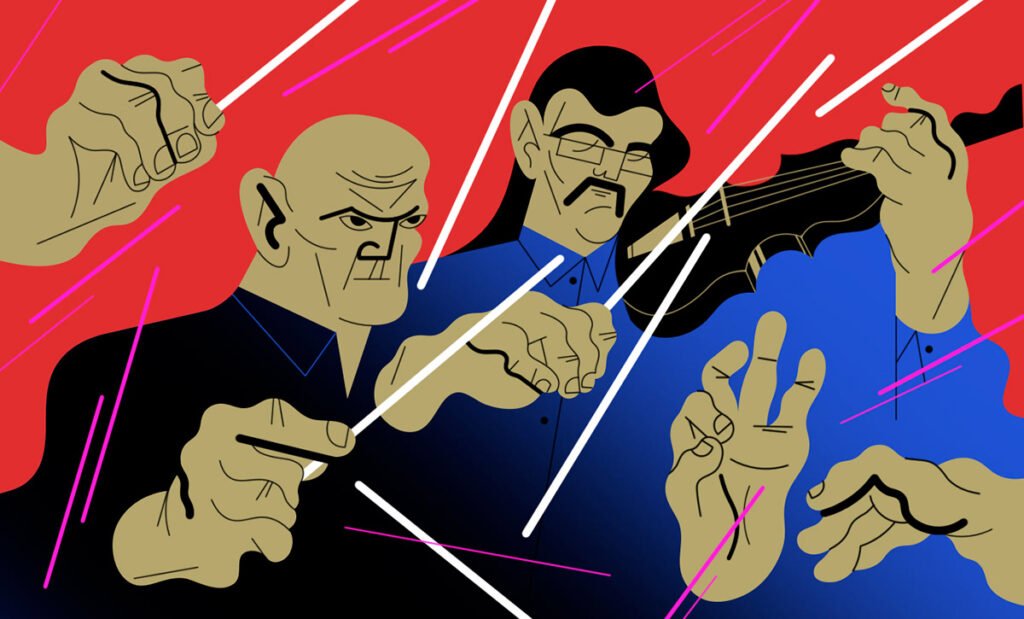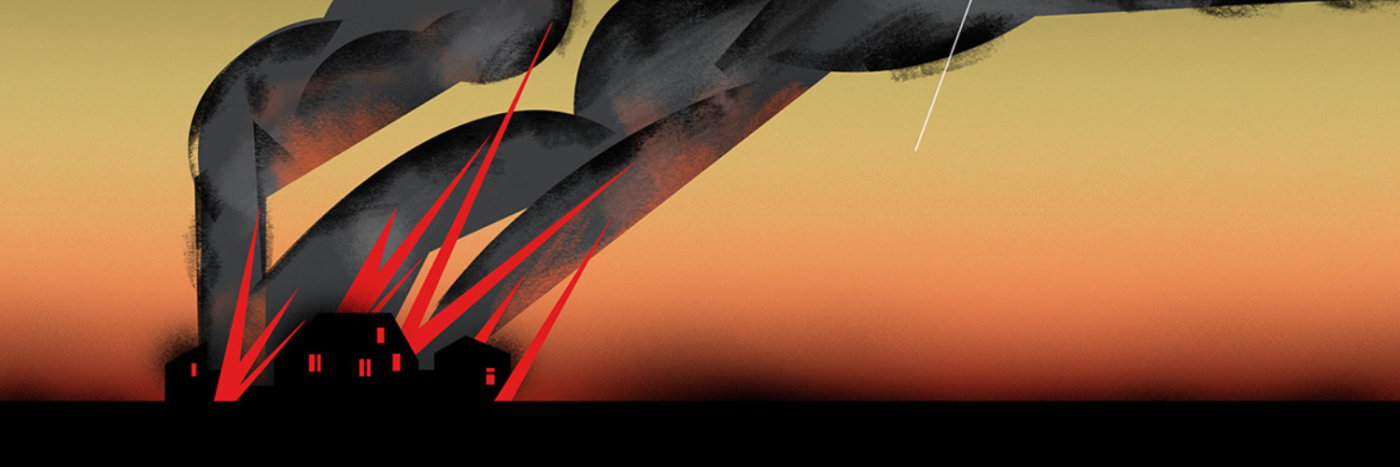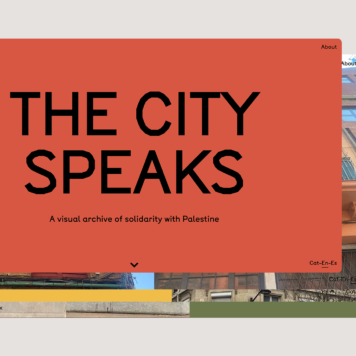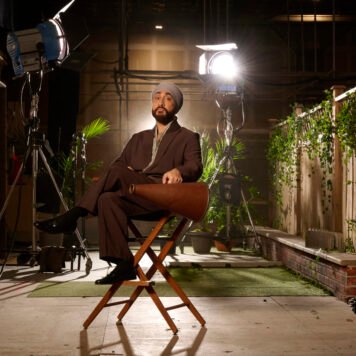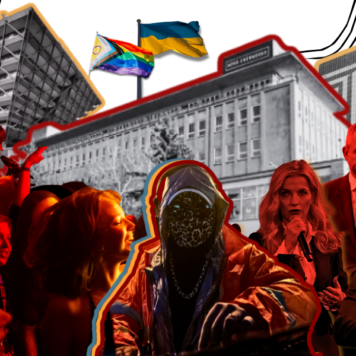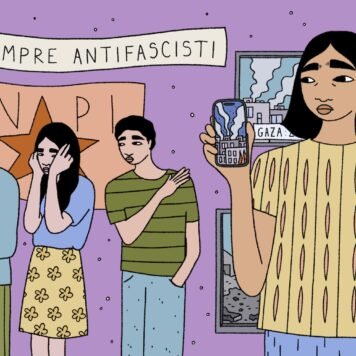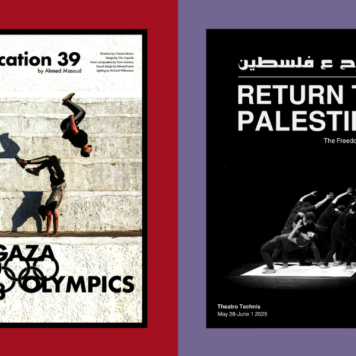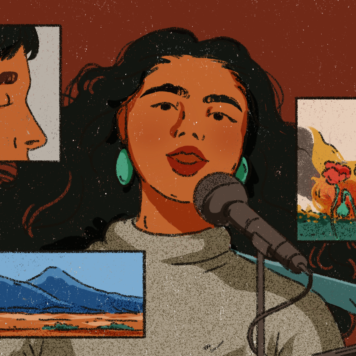Zhenya Oliinyk is an illustrator and cartoonist from Kyiv, Ukraine. Her recent pieces speak directly to the ongoing war that Russia has waged on her country, providing an intimate and often cutting perspective on how the conflict has impacted her life and outlook. I spoke to Zhenya to discover how her art has evolved during, and as a result of, the conflict, as well as her unique relationship to Kyiv.

Those who know Zhenya’s artistic style will immediately recognise her pieces, with their distinct personality and creative use of shadows, shapes, jagged lines and vivid colours.
What caught my eye the most from Zhenya’s latest collection were the simplistic black and white comic strips, which detail her inner thoughts about being both Ukrainian and an illustrator during the turmoil of war.
The almost featureless central figure representing herself, formed only with eyes and distinctive hairstyle – gives a frankness to the points she raises about her identity being consumed by the experiences before her, and the newfound international interest in her nation.
Comics as communication
In communicating political topics, comic strips have an interesting edge on other mediums. Zhenya explained to me that the difference between her other illustrations and her comics is often based on their purpose – illustrations usually bring out the point of the article it accompanies, yet comics function as texts in their own right.
“I used to work as a journalist,” she tells me from her home in Kyiv. “I really enjoyed it but it became way too demanding for me. Through comics, I can stay in my artistic domain and talk about more personal issues but at the same time create a coherent story as if using text. The thought process is like writing a column.”
A crucial element of Zhenya’s comics is using humour to express darker or sadder feelings. To Zhenya, jokes have been a core part of coping with the shock and devastation of Russia’s full-scale invasion of February 2022, so to apply it to her work seemed natural.
“This experience of war is so loaded with grief and helplessness that I find humour is actually essential in order to make my comics readable. In the beginning, there was a fair amount of shock. The attacks were so scary, humour felt like the only way to deal with it. If you have friends who survived the occupation of Bucha, you realise you are just lucky the same didn’t happen to you. Everyone needs a way to process everything we’ve been through and are still going through and for me my way of dealing with what’s going on is humour.”
Indeed, the concept of using humour as a coping mechanism is a practice which has spread throughout Ukraine, even to the social media posts of official Ukrainian ministries. Corneliu Bjola, professor of diplomatic studies at Oxford University, who specialises in digital messaging said of this: “Humour is helping Ukraine win the information war.”
It is also notable the way Ukraine has used memes and jokes in the English language as a bridge to reach internationals with no direct experience of war – serving to not just illustrate the situation but show the world a relatable form of creative resilience.
“Humour is also a shield in this situation, because you don’t want to feel vulnerable or weak when speaking about the war publicly,” Zhenya tells me. “Humour was always a part of my life, and of course it still is.”

Learning to love Kyiv
For Zhenya, expressing her feelings about life in wartime Kyiv also meant re-exploring her relationship to the city itself.
Amid the panic of Russia’s attack in early 2022, Zhenya immediately thought, like many Kyivans, to get out of the city. She and her boyfriend ended up briefly in Lviv, but finding too many people there already, moved to a village near Kyiv, staying in cramped conditions alongside other families. This stint outside her home was extremely brief.
Coming back to the city under siege was the spur for Zhenya to see Kyiv in a new light.
“Kyiv is not stuck where it was a year ago; it is still developing. What has really changed is my attitude towards the city,” she explains. “I used to not like Kyiv very much; I always wanted to move away – but now I’ve realised how much it is home to me.”
She goes on, “A few months before the invasion, my friend who had moved to Berlin came to Kyiv to visit. She told me how much she missed Kyiv. After leaving and coming back, I finally understood what she meant. I walked around when spring was starting and had to admit to myself, I love this city. I’ve even grown to love the parts I disliked the most.”
Experiencing Kyiv under attack has also made Zhenya think about the physical structures that make up the city, and how they, like the people, were all mobilised to defend it.
“I realised many of our subways were originally built as shelters during Soviet times. These heavy doors which block the entrances already existed. It was really surprising that the city felt prepared, at least a bit,” she muses.

What is ‘normal’ life in war?
Once Russian soldiers lost the Battle of Irpin and retreated from the occupied nearby city of Bucha in April 2022, leaving behind evidence of atrocities, life in Kyiv could resume some kind of normality. Restaurants and spaces such as nail and hair salons reopened. People busied themselves with work and errands – small acts of defiance. As Katja Petrowskaja wrote in Vanity Fair, “From the first days, work became for many a method of resistance to war, became a proof of existence.”
With this came a newfound sense of social cohesion, the idea that returning to normal habits was a way to support the beleaguered nation, rather than letting the impossible situation consume all.
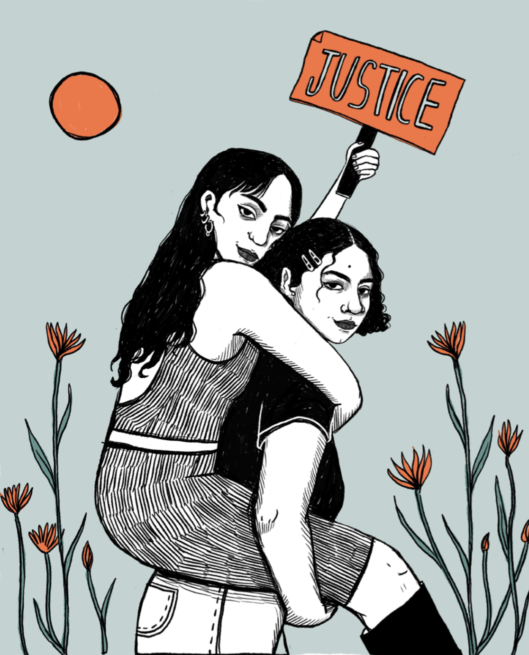
Join our mailing list
Sign up for shado's picks of the week! Dropping in your inbox every Friday, we share news from inside shado + out, plus job listings, event recommendations and actions ✊
Sign up for shado's picks of the week! Dropping in your inbox every Friday, we share news from inside shado + out, plus job listings, event recommendations and actions ✊
Zhenya explains, “When everything reopened, my friends and I joked that every time we go out to eat or have our nails or hair done, we are contributing to the Ukrainian economy. Even going up to the bar, we would say: No, we are not drinking – we are contributing to the economy!”
The threat of airstrikes remains very real in Kyiv, but due to how protracted the war has been and how its focus shifted to fronts in the east and south, Zhenya has noticed that residents of the city have begun to grow numb to wartime processes. Signs of war in Kyiv all seem to fade into background noise, she tells me: subway announcements on the war and seeing combatants around the city are normalised. When it’s been ongoing for so long, even airstrike warnings begin to grate. “Missile attacks are not normal,” she says. “But when you have three air raid alerts in a day, at some point you are like, oh come on, just fuck off.”
Community over burnout
Just as Zhenya has reconsidered her view of Kyiv, since the war many other Ukrainians began to consider how they relate to their fellow citizens. This can be seen through initiatives which banded together groups of people from certain sectors to steer collective resistance.
Though the themes explored in Zhenya’s work are undoubtedly personal, they’ve also come out of a collaborative spirit in the wider artistic community in Ukraine. Many of her friends and colleagues work in the field, but choose to not fuel competition against each other, instead forming a support network. This impulse only intensified after the full-scale invasion.
“The Ukrainian illustrators’ community was and still is really active in covering the war,” Zhenya says. “My friends are creating comics about it; a lot of people sell their art to raise for local charities and grassroots initiatives. The Ukrainian illustrators’ club Pictoric has also organised exhibitions for Ukrainian artists across European cities. They keep actively talking about the war and ways everyone can help – in this way we’ve seen a lot of illustrators become activists.”
This can be seen as part of Ukrainian societal mobilisation. From restaurants cooking for the elderly to clean-up raves of destroyed buildings, the sense of community has been a vital weapon of morale, contributing to Ukraine’s early show of optimism and resistance.
However, this was truer in the first six months of the conflict than today – since the war surpassed a whole year, Zhenya tells me that the dangers of burnout and fatigue run high.
“I feel much more depressed than at the beginning when it felt like it could end quickly. A whole year later, this experience starts to reveal itself – you are in a constant stressful situation. Once the adrenaline rush is gone, it hits your mental health pretty hard,” Zhenya explains.
“I don’t want Ukrainians to just be inspiration porn for the rest of the world. We are holding out for now but we are very tired. There is an ambiguity: we want to show the world we are tired and want this to stop, but at the same time prove our strength and belief that we will prevail.”
Art as power
Harnessing communal needs and creativity in times of crises is nothing new for Ukrainians.
Russian incursion into Ukrainian sovereignty did not start with the full-scale invasion of 2022. The 2014 Revolution of Dignity, also known as Maidan, was a crucial point, with huge protests at Kyiv’s Independence Square ousting pro-Russian president Viktor Yanukovych. Following this, Crimea was occupied and annexed by Russia, and pro-Russia separatists seized government buildings in Donetsk and Luhansk in Ukraine’s east.
Zhenya remembered feeling “useless” during this time, working as a culture reporter in a reportage-orientated newsroom, where Maidan dominated all. But out of the adverse conditions, Zhenya reflects that a spark of something bigger, more communal, was ignited.
“After Maidan ended, we had this documentary film festival in Kyiv called DocuDays. The opening screening was a compilation of what different people shot during the revolution. There were too many people in the theatre, we were sitting on the floor. I hadn’t cried once during Maidan but watching that movie, the whole crowd was weeping. It felt really cathartic because we were finally allowed to let our feelings out.”
It speaks to the liberatory nature of art, that Zhenya and countless other Ukrainian filmmakers, writers, musicians, and others have strived to create – not to forget about the issues in their country but to process and commemorate them as real. Exploring Ukrainian-made films and artworks around the conflict continues to be a form of antidote to the horrors.
Making space for Ukrainian creatives to tell their own stories and demonstrate their own forms of resistance is vital not only for advocacy but for greater understanding of the impacts facing frontline communities. Zhenya pointed to a good example of the global press centring those affected by war – Adweek handing their platform entirely over to Ukrainian editors, writers and creators for their issue ‘On Ukraine, By Ukrainains.’
Since the shadow of war can’t be erased, Zhenya reminds me that art can at least document the feelings and emotions from the ground in an accessible way that typical reportage can’t always replicate. This ensures Ukrainian voices are heard without the muffle of imposed opinions or speculation.
“The truth is we are consumed by the war – it can’t be denied,” Zhenya says. “Even if I left, I have family here and those ties don’t just stop existing. At the same time, I perceive a loss of part of my identity – and there’s no-one but Russia to blame for this.”
Ultimately, while Zenya mourns the perspective from which she has to speak from, agency for Ukrainians is what she strives for the most. “We want to speak, not have people speak about us outside our perspective,” she says. “Let us talk about ourselves.”
What can you do?
- Listen to Bosla Arts’ podcast The Art Persists with Zhenya, where she discusses internalised Ukrainophobia and further reflections on her art and experiences in times of war
- Follow Zhenya on Instagram
- Read more about Ukrainian illustrators
- Support the Ukrainian illustrators’ club – Pictoric – by sharing their work or helping organise an exhibition of their art in your community
- Read Bosla Arts’ Beyond Resilience publication, which features Zhenya and other artists operating in hostile conditions
- Donate to the BEARR Trust’s emergency appeal for Ukraine and Moldova, if you are able to
- Support Ukraine’s DocuDays film festival
- Read about other grassroots action and community building taking place in Ukraine
